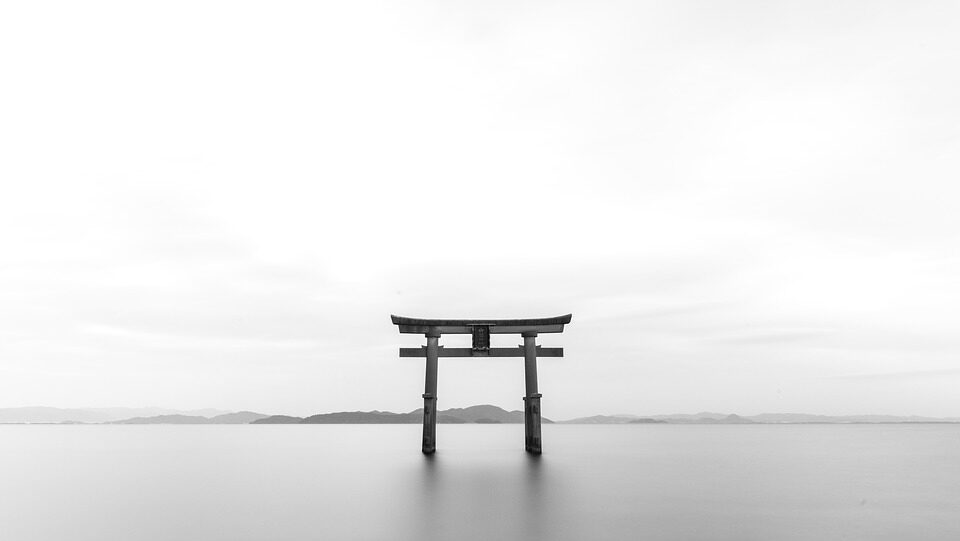【What kind of event is “Obon”?】 Find out about its period, roots and more!
In this article, we will tell the roots and period of “Obon(お盆)”, an essential part of Japanese culture.
What is “Obon”?
What kind of image do you have of “Obon”?
First of all, I think it is the biggest holiday of the summer.
Then there is the idea that it is a time to go back to the countryside and visit graves.
You may also have a vague idea that it is connected with “Bon Dance”.
What is “Obon” in the first place?
When does it start and end?
What do “Mukaebi” and “Okuribi” do?
目次
What is “Obon”?
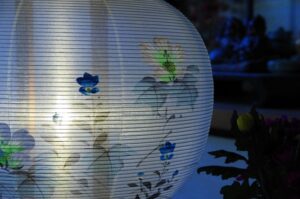
“Obon(お盆)” is “the period of time when the spirits of ancestors return to this world from the other world”, and “it is an event to welcome and worship them at home”.
Originally, “Obon” was held around July 15th of the lunar calendar, but the period varies from region to region, with some holding it in July of the lunar calendar and others in August of the new calendar.
During the Obon period, temporary shelves called “Bon-dana” (or “Syoryo-dana”) are set up, and “Hukaebi(welcoming fire)” and “Okuribi(sending fire)” are lit.
What are the roots of “Obon”?
The official name of “Obon” is “Ura-bon-e(盂蘭盆会)”.
In Sanskrit (an ancient Indian language), the word “Ura-bon” means “to save the suffering of those who are hung upside down” and is said to have originated from the episode of “Mokuren(目連)”, a disciple of Buddha.
Mokuren’s mother had fallen into hell and was hanging upside down in agony.
When he consulted with the Buddha about what to do, he told his disciple to make an offering on July 15th, and he did so and she was able to go to the Pure Land of Paradise.
This Buddhist teaching of “saving the deceased from suffering in the afterlife by making generous offerings to them” seems to have been combined with the belief in worshipping ancestors, which existed in Japan from ancient times, to form a custom unique to Japan.
About the “Obon” period

As for the period of “Obon”, the most common explanation is that it was changed from the lunar calendar to the new calendar in the Meiji era (1868-1912), as the July 15th in the lunar calendar falls in mid-August, it became “4 days between August 13th and 16th”.
However, there are regional differences, and in some places, such as urban areas of Tokyo (other than the Tama district), some areas of Kanagawa and Saitama, and the old city of Kanazawa, it became “4 days between July 13 and 16” when the calendar was switched to the new one.
Also, in Okinawa Prefecture and the Amami region of Kagoshima Prefecture, the dates still follow the lunar calendar, so the dates fluctuate.
The holiday period for companies is often set based on the 4 days between August 13 and 16, which is the most common.
The custom of “Obon”
The customs of “Obon” vary from region to region.
However, there are some that are common to many areas and some that have become famous.
①Bon-dana
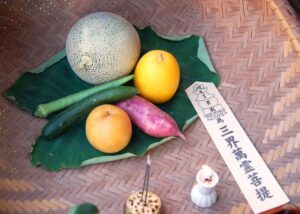
The “Bon-dana(盆棚)” is a shelf set up to welcome the spirits of the ancestors into the house and make them feel welcome.
It is also called “Syoryo-dana(精霊棚)”.
The way to make the “Bon-dana” and the offerings to be made vary from region to region, but here are some examples of how it is widely done.
“Bon-dana” was usually made in the morning of the 13th of the Obon.
In the past, the shelf was made by laying out Goza on the floor, putting up green bamboo at the four corners, stretching ropes, and lowering Hozuki.
The Ihai from the Buddhist altar were placed on a shelf made in this way.
Nowadays, it is easier to make a shelf inside the Buddhist altar, or more and more people put a small desk in front of the altar and use it as a “Bon-dana”.
After welcoming the deceased, we must pay our respects to the deceased in the morning and evening, and in the past, monks were invited to recite sutras on the 14th or 15th.
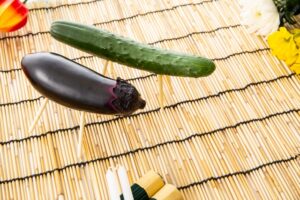
The most common offerings are fruits, vegetables, flowers, and dumplings.
One of the most famous ones is to stick bamboo into eggplants and cucumbers to make them look like legs, making them into oxen and horses.
It is said that this is because the spirits of the ancestors were thought to be vehicles for the spirits of the ancestors, coming from the other world on horses (fast horses to welcome them quickly) and returning on oxen (slow oxen to leave them behind).
②Mukaebi
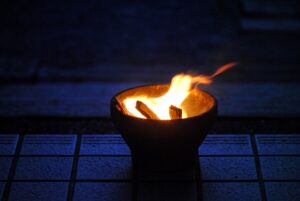
It is believed that the spirits of ancestors return on the evening of the 13th, and it is customary to light a welcoming fire in front of the gate to welcome them.
A welcoming fire is called “Mukaebi(迎え火)” in Japanese.
In the old custom, dried hemp stalks called “Ogara(麻幹)” are arranged in the shape of a well and burned on a plate.
It is also said that “if you step over a burning “Ogara”, it will ward off the plague”.
“Bon-chochin(盆提灯)” and “Bon-doro(盆灯籠)” are also a type of “Mukaebi”.
If it is difficult to light a fire in front of the gate, Bon-chochin(Jananese lanterns) are lit at the family temple or in front of the grave, and then taken home to be displayed.
The origin of “Mukaebi” dates back to the Kamakura period (1185-1333).
It is said that those who wander in the boundary between this world and the other world seek the light, and it is said that they used to bring back the incense flames from their graves.
When welcoming the spirits of those who have become Buddhas for the first time into the house (Niibon, 新盆), it is customary to hang white Bon-chochin in the eaves of the house earlier than usual.
③Okuribi
On the 16th, the last day of the Bon period, it is customary to light a “Okuribi(送り火, farewell fire)” in front of the gates of houses and family temples to brightly light the way for ancestors to return home.
In some areas, fires are lit in the mountains or along the riverbanks to show the “Okuribi” on a large scale.
One of the most famous is the “Kyoto Gozan Okuribi(京都五山送り火)”.
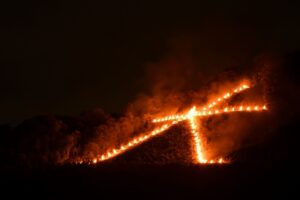
The “Kyoto Gozan Okuribi” is a collective term for the Okuribi lit on the five mountains of Kyoto: “Daimonji(大文字)” on Nyoigatake (Higashiyama), “Ship Shape” on Funayama-san (Nishigamo), “Myou and Hou (妙と法)” (Matsugasaki), “Torii Shape”on Saga Senoji, and “Left Daimonji (Ookita-yama).
The fires are lit at different times after 8:00 p.m. on the 16th, and the magnificent view has become a summer tradition along with the “Gion Festival(祇園祭)”.
④Syorou-nagashi
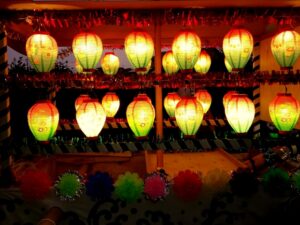
At this time, vegetables and fruits prepared for the Obon shelves are sometimes floated down rivers and into the sea, an event called “Syorou-nagashi(精霊流し, Spirit flow)”.
There are various scales, from simply wrapping them in mats or lotus leaves and letting them flow, to letting them flow in boats decorated with Bon lanterns called “Syorou-bune(精霊船)”.
The “Syorou-nagashi” held in Nagasaki City is particularly famous for its large scale.
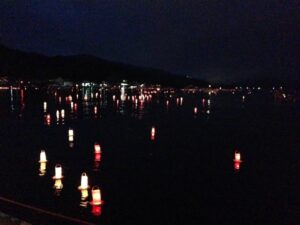
In some areas, lanterns are lit with candles and floated down rivers or into the sea.
It is called the “Tourou-nagashi(灯籠流し)”
This is also a type of Syorou-nagashi.
The lighting and floating of lanterns represents the spirits going out of the river and into the sea with the lanterns, and returning to the other world.
⑤Bon Dance
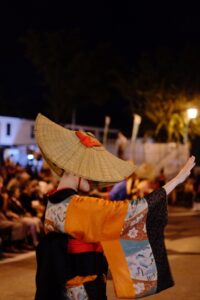
As the name suggests, “Bon Dance(盆踊り)” was originally a dance to make offerings to the spirits of ancestors who returned during the Obon period.
As an expression of the joy of welcoming the ancestors at Obon, it also became a ritual to send them to the other shore.
In addition to expressing gratitude, it was also meant to ward off evil.
Gradually, flutes and drums were added, and by the Edo period (1603-1868), songs and shamisen (three-stringed Japanese banjo) were added to make it more entertaining.
Nowadays, it has become one of the most enjoyable events as part of summer festivals.
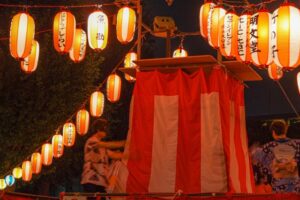
It is said that the origin of this dance is that the Nenbutsu Odori(念仏踊り) of Ippen Shonin(一遍上人), who founded the Jishu sect of Buddhism in the Kamakura period (1185-1333), was connected to the original custom of offering to ancestors.
There are also processional dances, such as the “Nenbutsu Odori” and “Dainen Odori(大念踊り)”, which are danced while walking in a line, and the famous “Awa Odori” is a typical example.
The most common form is the “Wa Odori(輪踊り)”, which is danced in a circle around a watchtower, and it is said to represent the ancient Japanese gods who came down to the center of the dance and formed a circle around them.
What is “Obon”? [ Obon as a part of Japanese culture ]
In this article, I focused on one Japanese event called “Obon”, and I thought it was a shining example of the beautiful Japanese tradition of cherishing ancestors in the Japanese culture, which is a combination of various customs and religious history.
Nowadays, we don’t even know the exact origin of “Obon” itself, and I think most of us are still practicing what has been handed down from generation to generation.
It may seem strange, but perhaps the original meaning of the custom has not changed, and we should continue to connect what remains today.
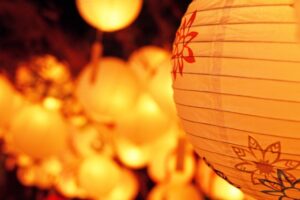
In the future, events will probably be simplified and modernized, but we should think carefully about the meaning of these events and pass them on.
